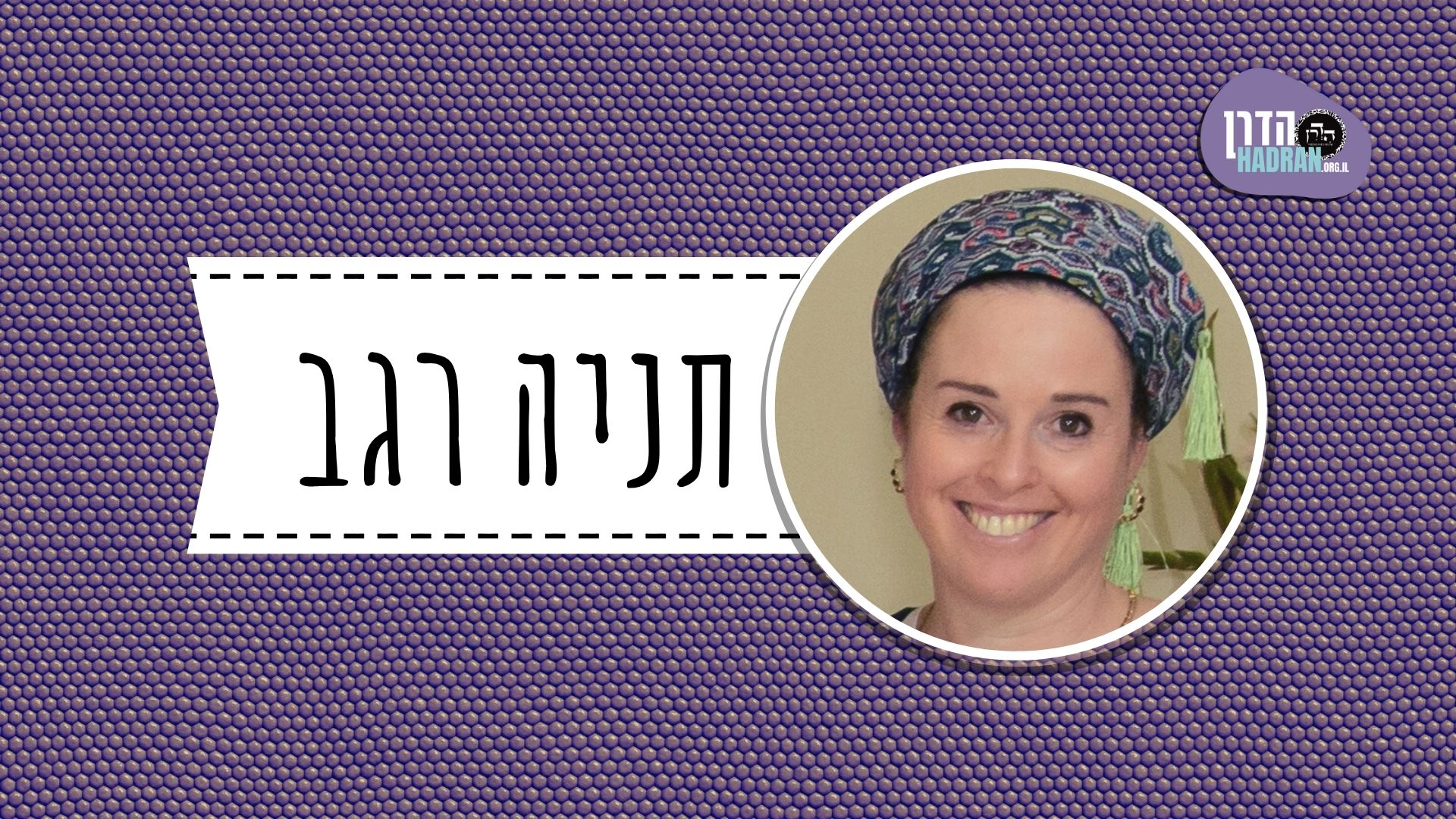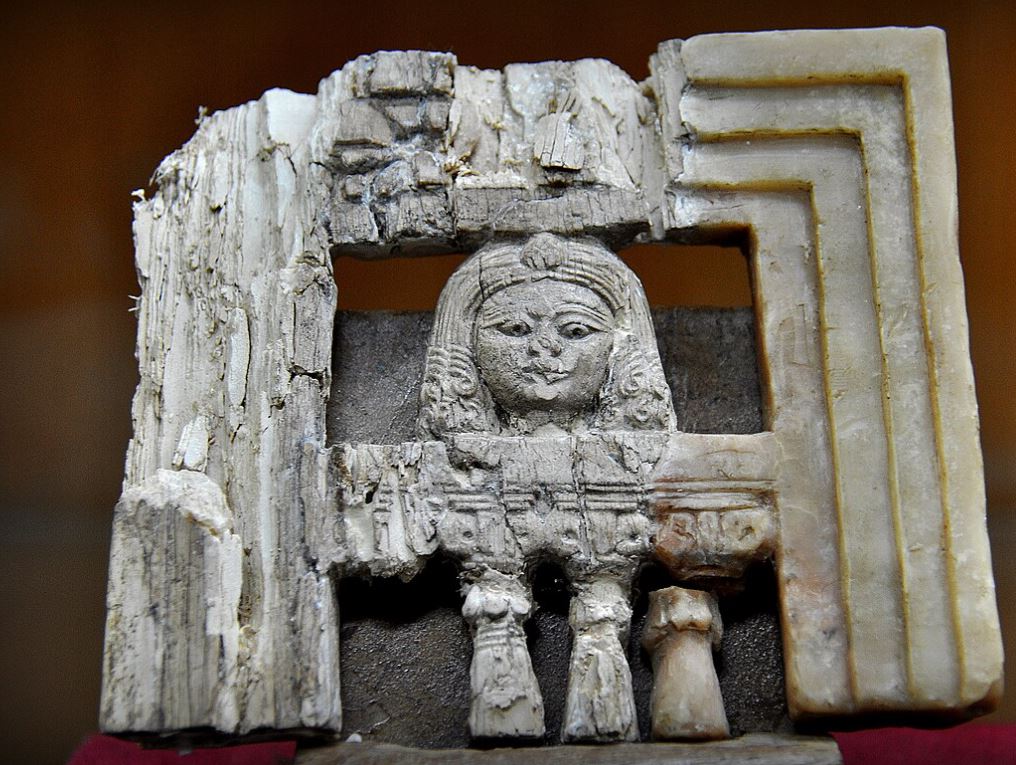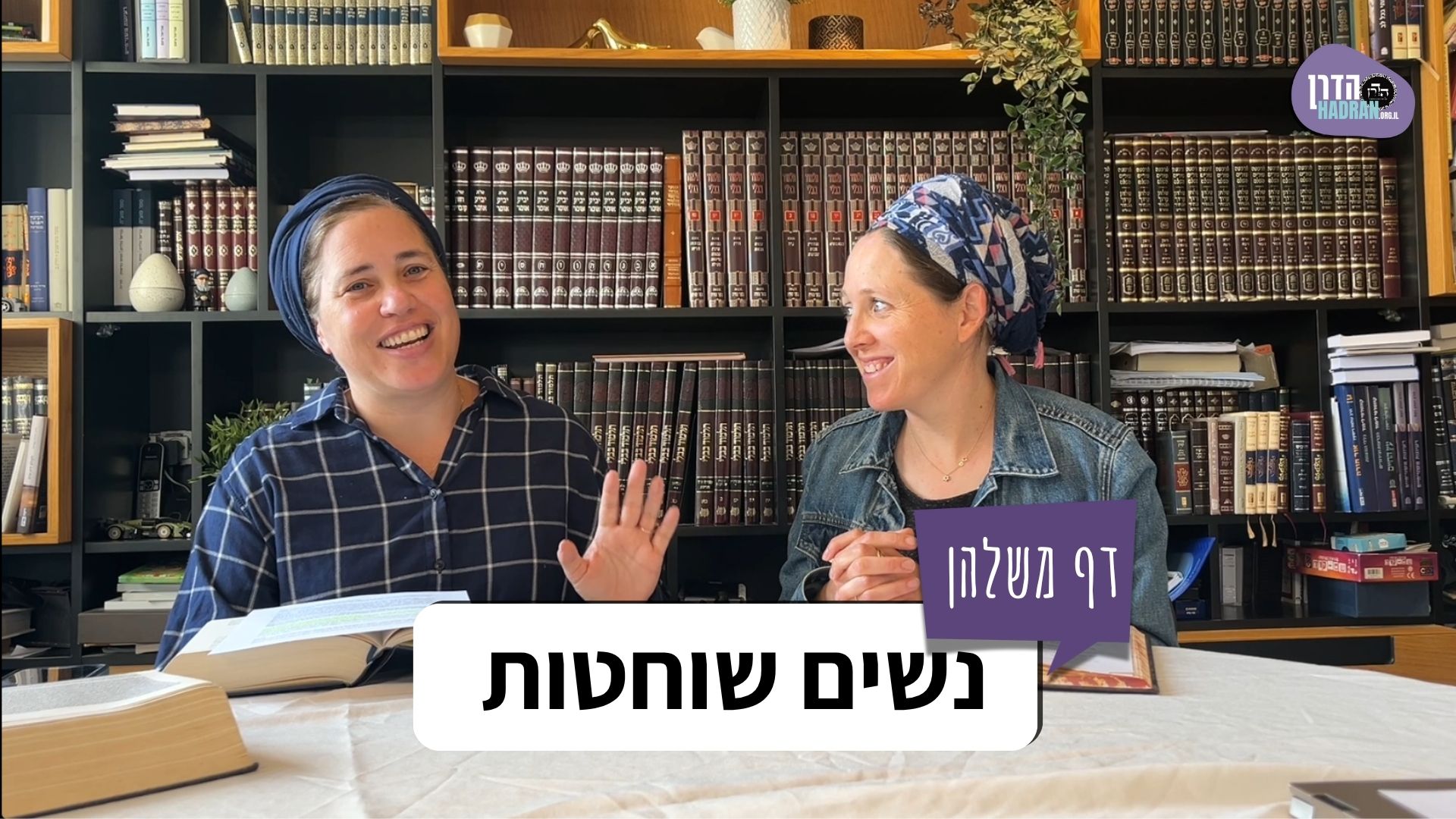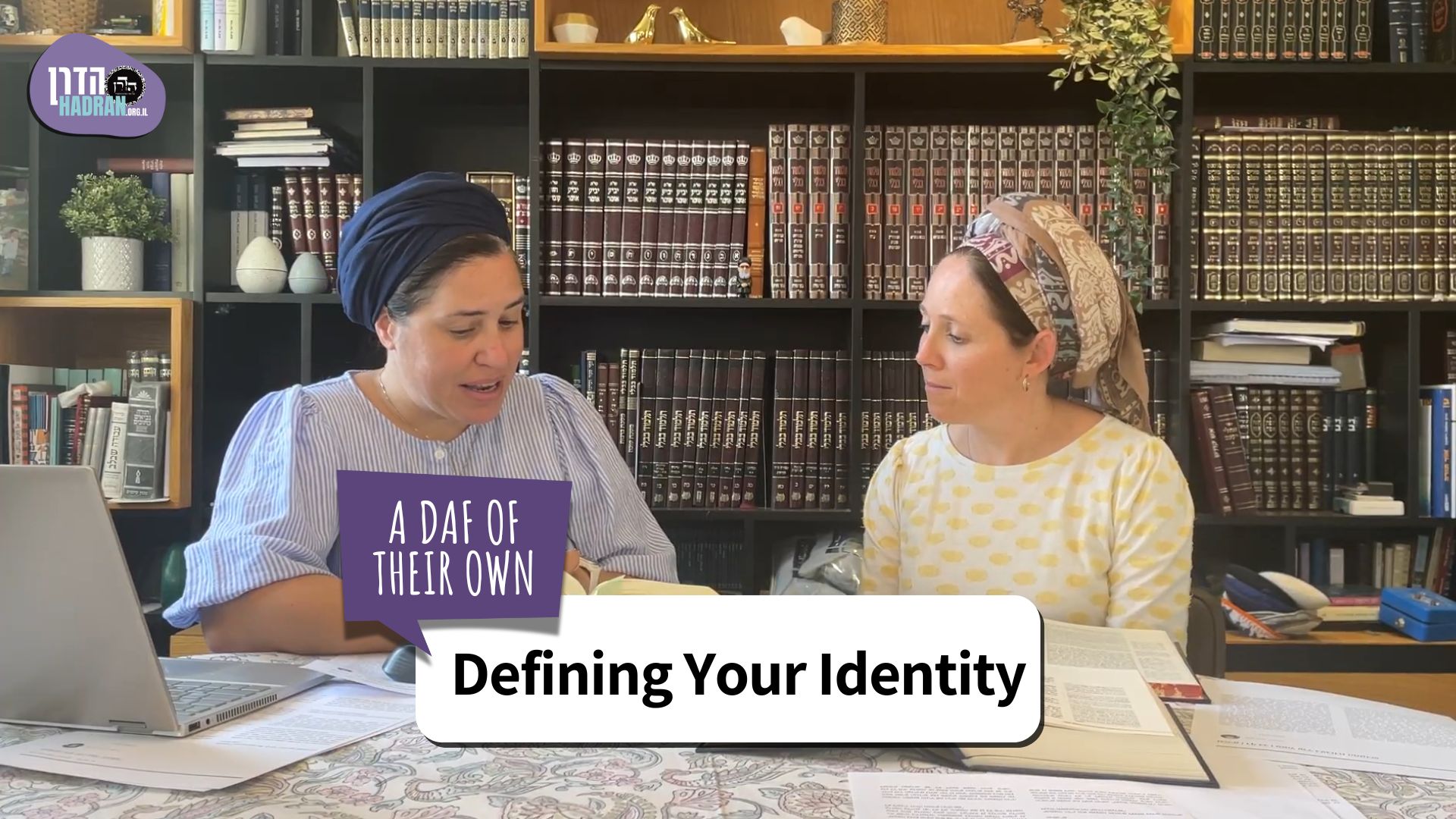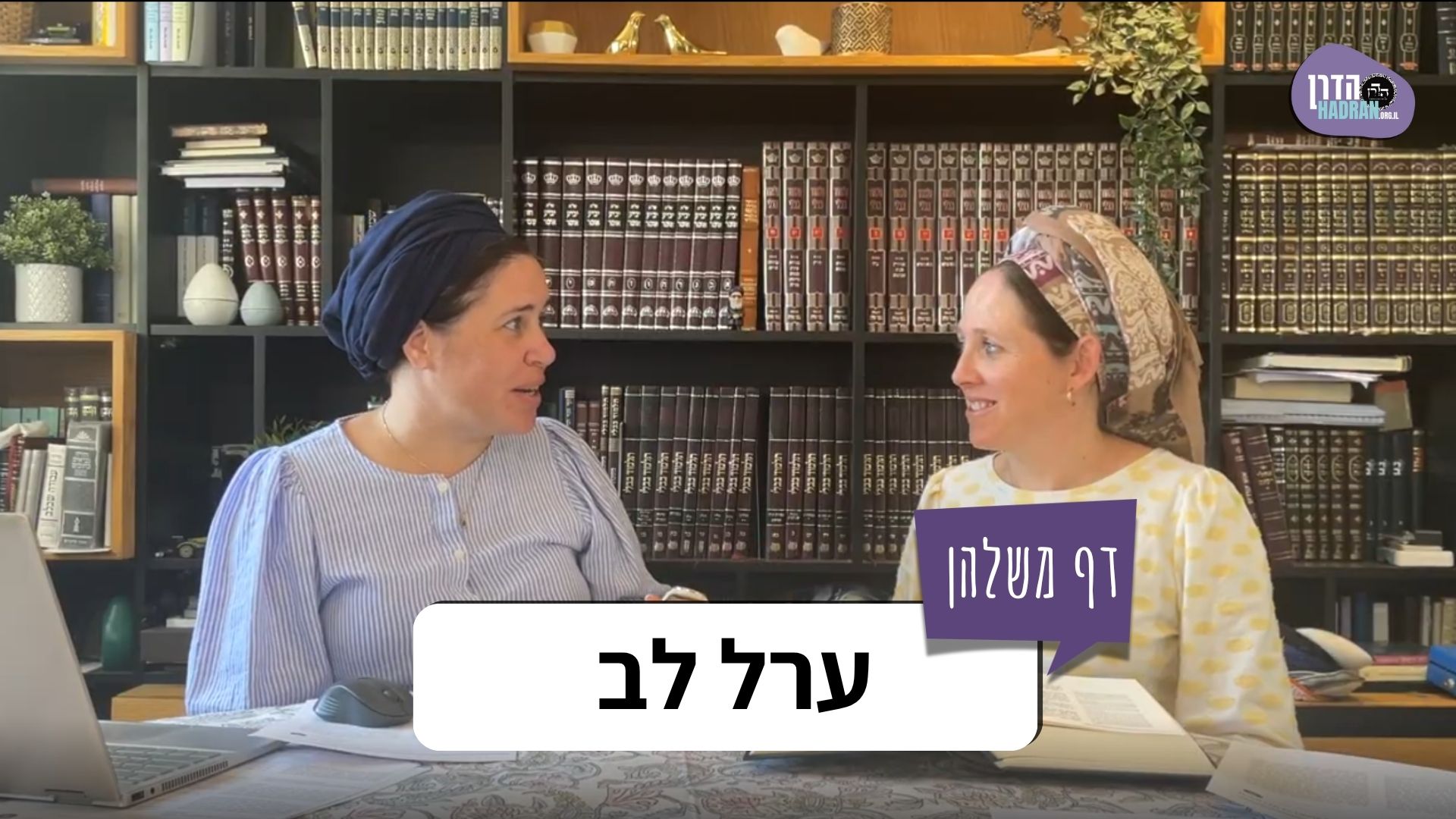Details regarding ribs that detach with or without part of the vertebra detaching with it. Details about an animal attacking – different opinions regarding what animals would inflict their venom and in what situations.
This month’s learning is sponsored by Beth Balkany in honor of their granddaughter, Devorah Chana Serach Eichel. “May she grow up to be a lifelong learner.”
Want to dedicate learning? Get started here:

This month’s learning is sponsored by Beth Balkany in honor of their granddaughter, Devorah Chana Serach Eichel. “May she grow up to be a lifelong learner.”
Delve Deeper
Broaden your understanding of the topics on this daf with classes and podcasts from top women Talmud scholars.
New to Talmud?
Check out our resources designed to help you navigate a page of Talmud – and study at the pace, level and style that fits you.
The Hadran Women’s Tapestry
Meet the diverse women learning Gemara at Hadran and hear their stories.
Chullin 52
חול הדק לא חיישינן חול הגס חיישינן אבק דרכים חיישינן תיבנא ועביד בזגא חיישינן לא עביד בזגא לא חיישינן
If the bird fell on fine sand, we need not be concerned, because the sand slides on impact, cushioning the fall. If it fell on coarse sand, we must be concerned, because there are large stones mixed into it. If it fell on dust of the road, we must be concerned, because the dust is compact and hard. If the bird fell on bundled straw, we must be concerned, because it is compact and hard. If the straw was not bundled, we need not be concerned.
חיטי וכל דמינייהו חיישינן שערי וכל דמינייהו חיישינן כל מיני קטניות אין בהם משום ריסוקי אברים לבר מן רוביא חימצי אין בו משום ריסוק אברים חפצי יש בו משום ריסוק אברים כללא דמלתא כל מידי דמשריק אין בו משום ריסוק אברים לא משריק יש בו משום ריסוק אברים
If the bird fell on wheat and all similar types of grain, such as spelt or rye, whose kernels are hard, we must be concerned. If it fell on barley and all similar types of grain, such as oats, we must be concerned. With regard to all types of beans, there is no concern due to possible shattered limbs if a bird fell on them, since their round shape causes the bird to slide when it hits them, except for fenugreek. With regard to peas, there is no concern due to possible shattered limbs, but with regard to chickpeas, there is a concern due to possible shattered limbs. The principle of the matter is: With regard to anything that slips to the sides on impact, there is no concern due to possible shattered limbs. And with regard to anything that does not slip, there is a concern due to possible shattered limbs.
דבוק רב אשי שרי אמימר אסר בחד גפא דכולי עלמא לא פליגי דשרי כי פליגי בתרי גפי מאן דאסר אמר לך היכי ניקום ומאן דשרי אמר לך אפשר דניקום אעיקבי דגפי
If the bird’s wings became stuck to a davuk, a board covered with glue set as a trap, and in trying to escape it fell to the ground while stuck to the board, Rav Ashi deemed the bird permitted, while Ameimar deemed it prohibited. The Gemara explains: In a case where only one wing was stuck to the board, everyone agrees that it is permitted, because the bird flaps with the other wing, lessening the impact of the fall. They disagree when both wings are stuck to the board. The one who deemed it prohibited could have said to you: How will it stand itself up so that it might dampen the impact? And the one who deemed it permitted could have said to you: It is possible for it to stand itself up by using the tips of its wings.
ואיכא דאמרי בתרי גפי כ”ע לא פליגי דאסיר כי פליגי בחד גפא מאן דשרי אמר לך אפשר דפרח בחד גפא ומאן דאסר כיון דבהאי לא מצי פרח בהאי נמי לא מצי פרח והילכתא בתרי גפי אסיר בחד גפא שרי:
And there are those who say: In a case where two wings were stuck to the board, everyone agrees that it is prohibited, because it cannot dampen the impact. They disagree when only one wing is stuck to the board. The one who deemed it permitted could have said to you: It is possible for it to fly with one wing and dampen the fall. And the one who deemed it prohibited could say: Since it cannot fly with this wing that is stuck to the davuk, it also cannot fly with that untrapped wing. The Gemara concludes: And the halakha is: In a case where two wings were stuck, it is prohibited. In a case where only one wing was stuck, it is permitted.
נשתברו רוב צלעותיה: תנו רבנן אלו הן רוב צלעות שש מכאן ושש מכאן או אחת עשרה מכאן ואחת מכאן
§ The mishna states that if most of an animal’s ribs were fractured, it is a tereifa. The Sages taught: These are most of the ribs: Six from here and six from there, i.e., six on each side, or eleven from here and one from there. Twenty-two ribs are significant for matters of tereifot, eleven on each side. Twelve fractured ribs constitutes a majority.
אמר זעירי ומחציין כלפי שדרה אמר רבה בר בר חנה אמר רבי יוחנן ובצלעות גדולות שיש בהן מוח
Ze’eiri says: And this applies only when the ribs were fractured from the half of the rib toward the spine, but not if they were fractured on the other half. Rabba bar bar Ḥana says that Rabbi Yoḥanan says: And this applies only to fractures occurring in large ribs that contain marrow; fractures in small ribs do not render the animal a tereifa.
אמר עולא בן זכאי אמר נעקרו ברוב צד אחד נשתברו ברוב שני צדדין רבי יוחנן אמר בין נעקרו בין נשתברו ברוב שני צדדין
§ Ulla said that ben Zakkai says: If the ribs were dislocated from the spine, even a majority of one side, i.e., six dislocated ribs, is enough to render the animal a tereifa. Only if the ribs were broken is a majority of both sides necessary. Rabbi Yoḥanan says: Whether they were dislocated or broken, the animal is a tereifa only with a majority of both sides.
אמר רב נעקרה צלע וחוליא עמה טרפה אמרי ליה רב כהנא ורב אסי לרב נעקרה צלע מכאן וצלע מכאן וחוליא קיימת מהו אמר להו גיסטרא קאמריתו
Rav says: If a rib was dislocated and the attached vertebra was torn out with it, the animal is a tereifa, even if the spinal cord remains intact. Rav Kahana and Rav Asi said to Rav: If a rib was dislocated from here and another rib from there, i.e., both ribs connected to a single vertebra were dislocated, but the vertebra itself remains intact, what is the halakha? Rav said to them: Are you saying that an animal that was sliced in half is a tereifa? This animal is considered to have been sliced and already has the status of a carcass, as it is already considered dead (see 21a).
והא רב נמי גיסטרא קאמר כי קאמר רב צלע בלא חוליא
The Gemara asks: But didn’t Rav also say that a sliced animal is a tereifa, since he said that if a rib was dislocated along with the attached vertebra, the animal is a tereifa? In such a case, the opposite rib is inevitably detached. If so, the animal should be considered a carcass. The Gemara responds: When Rav said that such an animal is a tereifa, he was referring to a case where the rib was dislocated without the vertebra.
והא צלע וחוליא קאמר צלע וחצי חוליא
The Gemara asks: But didn’t Rav explicitly say his statement with regard to a rib and vertebra that were dislocated? The Gemara responds: Rav meant that if a rib and half its attached vertebra were dislocated, the animal is a tereifa. The opposite rib, however, is intact and connected to the remainder of the vertebra.
מכלל דרב כהנא ורב אסי צלע בלא חוליא אמרי ואמר להו גיסטרא קאמריתו והאמר עולא בן זכאי אמר נעקרו ברוב צד אחד נשתברו ברוב שני צדדין
The Gemara challenges: By inference, one may conclude that Rav Kahana and Rav Asi stated their question with regard to a less serious case, i.e., where a rib from each side was torn out without the vertebra being damaged at all. And yet, Rav said to them: Are you saying that an animal that was sliced in half is a tereifa? Rather, this animal is a carcass and is certainly prohibited. And how could Rav say this? But didn’t Ulla say that ben Zakkai says: If the ribs were dislocated, even a majority of one side is enough to render the animal a tereifa, while if the ribs were broken, a majority of both sides is necessary? If so, any animal with fewer than six dislocated ribs should be kosher, as long as the spine is undamaged.
אמר לך התם זה שלא כנגד זה הכא זה כנגד זה
The Gemara responds: Rav could have said to you: There, where ben Zakkai says that six dislocated ribs on one side render the animal a tereifa, this is referring only to ribs not dislocated one opposite the other. Here, where Rav says that two dislocated ribs render the animal a carcass, this is referring to ribs dislocated one opposite the other.
והאמר רבי יוחנן ברוב שני צדדין וברוב שני צדדין אי אפשר דלא קיימא חד מינייהו זה כנגד זה
The Gemara asks: But doesn’t Rabbi Yoḥanan say that the animal is a tereifa only if a majority of both sides was dislocated, and in a majority of both sides, it is impossible that one of them is not situated opposite another? Still, Rabbi Yoḥanan says that the animal is a tereifa and not a carcass.
התם בוכנא בלא אסיתא הכא בוכנא ואסיתא
The Gemara responds: There, Rabbi Yoḥanan is referring to a case where the pestle, i.e., the end of the rib, was torn out without the mortar, the socket of the vertebra in which it sits, leaving the spine completely intact. In such a case, the animal is a tereifa only if twelve ribs were dislocated, even though this necessarily includes one rib opposite another. Here, where Rav says that two dislocated ribs opposite one another render the animal a carcass, that is referring to a case where the pestle and mortar were torn out together, damaging the spine.
אי הכי היינו דרב לא שמיע להו דרב
The Gemara asks: If so, why did Rav Kahana and Rav Asi ask anything of Rav? Their case in question is identical to the statement of Rav. If Rav says that the animal is a tereifa if a rib and part of its vertebra were dislocated, that should be the halakha all the more so if ribs opposite one another were dislocated in addition to part of the attached vertebra. The Gemara responds: Rav Kahana and Rav Asi did not hear that statement of Rav.
וליבעו מיניה כדרב סברי ליבעי מיניה חדא דפריש לן תרתי דאי בעינן מיניה חדא הניחא אי אמר לן טרפה כל שכן תרתי אי אמר לן כשרה אכתי תרתי קא מיבעיא לן
The Gemara persists: But if so, let them ask about the simpler case of one dislocated rib, like that which Rav himself discussed. Why ask specifically about two ribs opposite one another? The Gemara responds: They reasoned: Let us ask him one question through which he will explain to us two different cases. As, if we ask him about only one dislocated rib, this works out well if he says to us that the animal is a tereifa, because we can infer that all the more so if two ribs opposite one another are dislocated, the animal is a tereifa. But if he says to us that it is kosher, we must still ask with regard to a case of two dislocated ribs.
אי הכי השתא נמי דקא בעי מיניה תרתי הניחא אי אמר להו כשרה כל שכן חדא ואי אמר להו טרפה אכתי חדא מיבעיא להו
The Gemara objects: If that is so, then now, too, when they ask him about two ribs, they may not receive an answer with regard to both cases. Granted, this works out well if he says to them that an animal with two dislocated ribs opposite one another is kosher, since they can infer that all the more so it is kosher if only one rib is dislocated. But if he says to them that it is a tereifa, they must still ask with regard to a case of only one dislocated rib.
סברי אם כן מירתח קא רתח חדא טרפה תרתי מיבעיא
The Gemara responds: They reasoned that it is better to ask about a case where two ribs opposite one another were dislocated, because if it is so that Rav holds that the animal is a tereifa if even one rib is dislocated, then he would become angry and respond: If an animal with even one dislocated rib is a tereifa, is it necessary to ask about an animal with two dislocated ribs?
והא קא אמרי ליה ולא רתח כיון דקאמר להו גיסטרא קאמריתו היינו ריתחיה
The Gemara objects: But they did say this question to him and he did not become angry, despite the fact that he holds that even one dislocated rib renders the animal a tereifa. The Gemara responds: When he said to them: Are you saying that an animal that was sliced in half is a tereifa, this is his anger. Rav Kahana and Rav Asi understood from this response that an animal with two dislocated ribs opposite one another is a carcass, but an animal with one dislocated rib is a tereifa.
אמר רבה בר רב שילא אמר רב מתנא אמר שמואל נעקרה צלע מעיקרה וגולגולת שנחבסה ברובה ובשר החופה את רוב הכרס ברובו טרפה
§ Rabba bar Rav Sheila says that Rav Mattana says that Shmuel says: If a rib was ripped from its root, or if the skull was crushed in its majority, or if the flesh that envelops the majority of the rumen was damaged in its majority, the animal is a tereifa.
נעקרה צלע מעיקרה טרפה ורמינהו
The Gemara asks: Did Shmuel really say that if a rib was ripped from its root, the animal is a tereifa? But raise a contradiction from a mishna (Oholot 2:3):
כמה חסרון בשדרה בית שמאי אומרים שתי חוליות ובית הלל אומרים חוליא אחת ואמר רב יהודה אמר שמואל וכן לטרפה
How much is considered a deficiency in the spine of a corpse so that it will not be considered a full corpse that would render one impure in a tent? Beit Shammai say: Two missing vertebrae, and Beit Hillel say: One vertebra. And Rav Yehuda says that Shmuel says: And just as Beit Shammai and Beit Hillel disagree with regard to ritual impurity, so too they disagree with regard to a tereifa, i.e., according to Beit Hillel an animal missing only one vertebra is a tereifa. Evidently, Shmuel holds that a missing vertebra renders the animal a tereifa, but a dislocated rib does not.
הכא צלע בלא חוליא התם חוליא בלא צלע
The Gemara responds: This is not difficult. Here, where Shmuel says that a rib ripped from its root renders the animal a tereifa, he is referring to a case where the rib was torn out without the vertebra. There, where he says that a missing vertebra renders the animal a tereifa according to Beit Hillel, he is referring to a case where the vertebra was missing without the rib being dislocated. But if the rib itself was ripped from its root, the animal is a tereifa.
בשלמא צלע בלא חוליא משכחת לה אלא חוליא בלא צלע היכי משכחת לה בשילהי כפלי
The Gemara asks: Granted, with regard to a case where a rib was dislocated without the vertebra, you find this commonly. But how can you find a case of a missing vertebra without a dislocated rib? The Gemara responds: This can occur at the ends of the flanks, where there are vertebrae with no ribs attached to them.
מתקיף לה רב אושעיא ולתנייה גבי קולי בית שמאי וחומרי בית הלל אמר ליה רב כי איתשיל לענין טומאה איתשיל דהוו להו בית שמאי לחומרא:
Shmuel said that just as Beit Shammai and Beit Hillel disagree with regard to ritual impurity, so too they disagree with regard to a tereifa. Rav Oshaya objects to this statement: But if that is so, then the opinion of Beit Hillel is the more stringent one, as they hold that even one missing vertebra renders the animal a tereifa. Accordingly, let the tanna teach this dispute along with the list of leniencies of Beit Shammai and stringencies of Beit Hillel in tractate Eduyyot. Rav said to him: When the question was asked, it was asked with regard to the ritual impurity of a corpse. That is the source of the dispute between Beit Hillel and Beit Shammai, and on that matter, Beit Shammai constitute the stringent opinion. The parallel disagreement with regard to tereifot is not mentioned explicitly in any mishna or baraita, and it was therefore omitted from the list in tractate Eduyyot.
וגולגולת שנחבסה ברובה: בעי רבי ירמיה רוב גובהה או רוב היקיפה תיקו:
The Gemara returns to Shmuel’s statement: Or if the skull was crushed in its majority, the animal is a tereifa. Rabbi Yirmeya raises a dilemma: Is this referring to the majority of its height or the majority of its circumference? The Gemara responds: The dilemma shall stand unresolved.
ובשר החופה רוב הכרס ברובו: בעי רב אשי ברוב קרוע או ברוב נטול
Shmuel also said: Or if the flesh that envelops the majority of the rumen was damaged in its majority, the animal is a tereifa. Rav Ashi raises a dilemma: Is this referring even to a case where the majority of the length of the flesh was torn? Or is it referring only to a case where the majority of the flesh was removed, but if it was torn along the majority of its length the animal remains kosher?
תפשוט ליה מדתנן כרס הפנימית שניקבה או שנקרע רוב החיצונה ואמרי במערבא משמיה דרבי יוסי בר’ חנינא כל הכרס כולו זו היא כרס הפנימי ואי זהו כרס החיצונה בשר החופה את רוב הכרס
The Gemara responds: Resolve the dilemma from that which we learned in the mishna: If the internal rumen was perforated or most of the external rumen was torn, the animal is a tereifa. And in the West, Eretz Yisrael, they said in the name of Rabbi Yosei, son of Rabbi Ḥanina: The entire rumen is the internal rumen. And if so, which is the external rumen? It is the flesh that envelops the majority of the rumen. Apparently, the animal is a tereifa even if the flesh is torn in its majority.
מידי הוא טעמא אלא לשמואל (הכי אמר) רבי יעקב בר נחמני אמר שמואל מקום שאין בו מילת:
The Gemara rejects the proof: This explanation is meant only to clarify the statement of Shmuel, and Shmuel does not agree with the opinion of Rabbi Yosei, son of Rabbi Ḥanina, as this is what Rabbi Ya’akov bar Naḥmani said that Shmuel said: The case of: Most of the external rumen was torn, mentioned in the mishna, where the animal is a tereifa, is not referring to where the flesh enveloping the majority of the rumen was torn, but rather where the majority of the rumen itself was torn. The internal rumen is the place in the rumen that has no wool, i.e., downy projections on the inside of the rumen. Accordingly, one cannot prove anything about the statement of Shmuel based on an explanation of the mishna offered by Rabbi Yosei, son of Rabbi Ḥanina.
ודרוסת הזאב: אמר רב יהודה אמר רב בבהמה מן הזאב ולמעלה ובעופות מן הנץ ולמעלה
§ The mishna states: And an animal that was clawed by a wolf is a tereifa. Rav Yehuda says that Rav says: In the case of an animal, it is a tereifa if it was clawed by any predator from the size of a wolf and upward. And with regard to birds, they are tereifot if they were clawed by any predator from the size of a hawk and upward.
למעוטי מאי אילימא למעוטי חתול תנינא ודרוסת הזאב וכי תימא הא קא משמע לן דזאב בגסה נמי דריס והא תנן רבי יהודה אומר דרוסת הזאב בדקה ודרוסת ארי בגסה
The Gemara asks: What does this statement of Rav, that an animal is a tereifa if it was clawed by a predator at least as large as a wolf, serve to exclude? If we say it serves to exclude a cat that clawed an animal, since it is smaller than a wolf, we already learned in the mishna: And an animal clawed by a wolf is a tereifa. One can infer from this that cats do not render an animal a tereifa. And if you would say: This mishna teaches us that a wolf can also effectively claw a large animal, e.g., cattle, but it may still be that a cat can render a small animal a tereifa, this cannot be; didn’t we learn in the mishna that Rabbi Yehuda says: If it was clawed by a wolf in the case of a small animal, or clawed by a lion in the case of a large animal, the animal is a tereifa?
וכי תימא רבי יהודה מפלג פליג והאמר רבי בנימין בר יפת אמר רבי אלעא לא בא רבי יהודה אלא לפרש דברי חכמים
And if you would say that Rabbi Yehuda disagrees with the Rabbis, and they hold that a wolf can also render large livestock tereifa by clawing, this too is impossible, as doesn’t Rabbi Binyamin bar Yefet say that Rabbi Ela says: The statement of Rabbi Yehuda in the mishna comes only to explain the statement of the Rabbis?
גברא אגברא קא רמית איבעית אימא לעולם למעוטי חתול מהו דתימא אורחא דמלתא קתני קא משמע לן
The Gemara responds: Are you setting the statement of one man against the statement of another man? Even if Rabbi Ela holds that Rabbi Yehuda comes only to explain the statement of the Rabbis, Rav may still hold that Rabbi Yehuda disagrees with the Rabbis. Or, if you wish, say instead: Actually, everyone agrees that a wolf can render only a small animal a tereifa through clawing. Nevertheless, the statement of Rav serves to exclude a cat from the ability to render even a small animal a tereifa. Lest you say that the mishna taught about a wolf only because this is the manner in which the matter typically occurs, but a cat may in fact render a small animal a tereifa, Rav teaches us that it is referring specifically to a wolf.
אמר רב עמרם אמר רב חסדא דרוסת חתול ונמייה בגדיים וטלאים דרוסת חולדה בעופות מיתיבי דרוסת חתול נץ ונמייה עד שתינקב לחלל אבל דרוסה לית להו
§ Rav Amram says that Rav Ḥisda says: If an animal was clawed by a cat or a mongoose, in the case of kids or lambs, which are very small, it is a tereifa. If it was clawed by a weasel in the case of birds, it is a tereifa. The Gemara raises an objection from a baraita: An animal clawed by a cat, hawk, or mongoose is not rendered a tereifa until one of its internal organs is perforated to its recesses. One may infer: But they, i.e., a cat, hawk, and mongoose, do not have the ability to render an animal a tereifa through the clawing itself.
ותסברא נץ לא דריס והתנן ודרוסת הנץ הא לא קשיא כאן בעופות כאן בגדיים וטלאים
The Gemara questions the inference: And can you understand that a hawk does not effectively claw an animal? But didn’t we learn in the mishna: And a small bird clawed by a hawk is rendered a tereifa? The Gemara responds: That is not difficult. Here, where the mishna states that a hawk can effectively claw, it is with regard to birds, while there, where the baraita states that a hawk does not effectively claw, it is with regard to kids and lambs.
מכל מקום לרב חסדא קשיא הוא דאמר כי האי תנא דתניא בריבי אומר לא אמרו אין דרוסה אלא במקום שאין מצילין אבל במקום שיש מצילין יש דרוסה
The Gemara returns to its initial objection: In any case, the baraita poses a difficulty for Rav Ḥisda, who says that a cat may render kids and lambs tereifot through clawing. The Gemara responds: Rav Ḥisda states his opinion in accordance with the opinion of that tanna, as it is taught in a baraita: The Distinguished One says: They said that a kid is not effectively clawed by a cat only in a place where there are none present to save it. But in a place where there are bystanders trying to save the kid, it is effectively clawed, since the cat is angered and injects venom into the wound. Rav Ḥisda is referring specifically to the latter case.
ובמקום שאין מצילין אין דרוסה והא ההיא תרנגולת דהואי בי רב כהנא דרהט חתול בתרה ועל לאידרונא ואיתחיד דשא באפיה ומחייה לדשא בסיחופיה ואשתכח עלה חמשה קורטי דמא
The Gemara asks: And in a place where there are none to save the kid, is it not effectively clawed? But there was a certain hen that was in the house of Rav Kahana, which a cat pursued, and the cat entered after it into a small room, and the door shut in the cat’s face, and it struck the door with its paws in anger. And afterward, five drops of blood, i.e., venom, were found on the door. Apparently a cat is venomous even if no one is present to save its prey.
הצלת עצמה נמי כהצלת אחרים דמי ורבנן זיהרא אית ליה ולא קלי זיהריה
The Gemara responds: For a cat, saving itself is also considered like saving others. Since the cat felt threatened, it acted as it would if there had been someone present to defend the hen. The Gemara asks: And the Rabbis, who state in the baraita that a cat can never effectively claw a small animal, even when there are bystanders attempting to save its prey, how do they explain this incident? The Gemara responds: According to the Rabbis, a cat does have venom, but its venom does not burn enough to render the animal a tereifa.
איכא דאמרי הא מני בריבי היא דתניא בריבי אומר לא אמרו יש דרוסה אלא במקום שיש מצילין אבל במקום שאין מצילין אין דרוסה
There are those who state the details of this exchange differently: After raising an objection to the statement of Rav Ḥisda from the baraita that states that a cat cannot effectively claw kids and lambs, the Gemara responds: In accordance with whose opinion is this baraita? It is in accordance with the opinion of the Distinguished One, as it is taught in a baraita: The Distinguished One says: They said that a kid is effectively clawed by a cat only in a place where there are bystanders present to save it. But in a place where there are none present to save the kid, it is not effectively clawed. The baraita, then, discusses a case where there are none present to save it. Rav Ḥisda agrees with the Rabbis that a cat can effectively claw an animal even when there are none present to save it.
ובמקום שאין מצילין אין דרוסה והא ההיא תרנגולת דהואי בי רב כהנא דרהט חתול בתרה ועל לאידרונא ואיתחיד דשא באפיה ומחייה לדשא בסיחופיה ואישתכח עליה חמשה קורטי דמא הצלת עצמה נמי כהצלת אחרים דמיא
The Gemara asks: But in a place where there are none present to save the kid, is it not effectively clawed? But there was a certain hen that was in the house of Rav Kahana, which a cat pursued, and the cat entered after it into a small room, and the door shut in the cat’s face, and it struck the door with its paws in anger. And afterward, five drops of blood, i.e., venom, were found on the door. The Gemara responds: For a cat, saving itself is also considered like saving others.
בעא מיניה רב כהנא מרב
The Gemara relates that Rav Kahana asked Rav:





